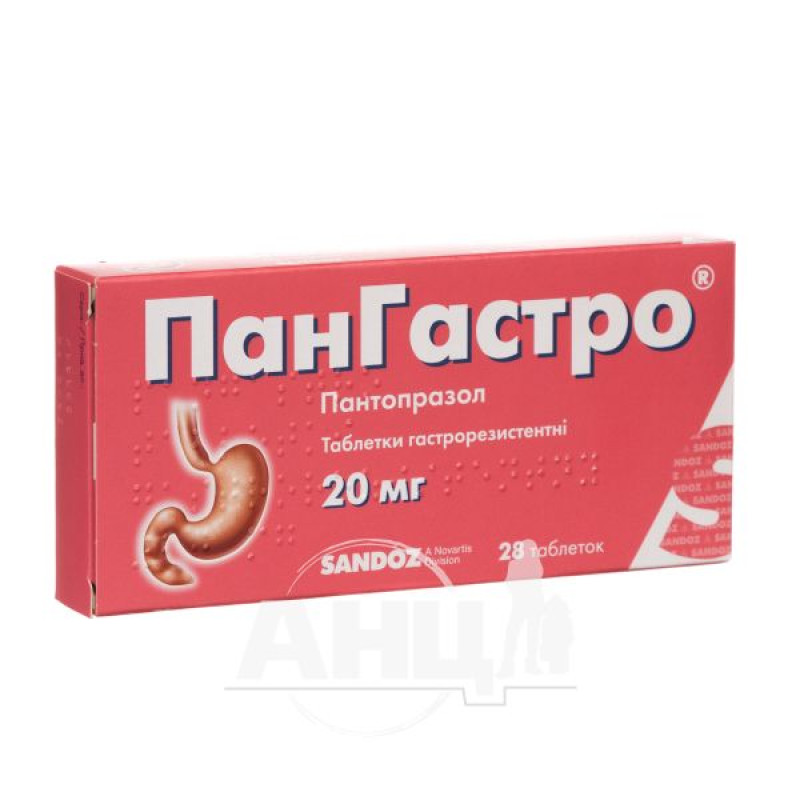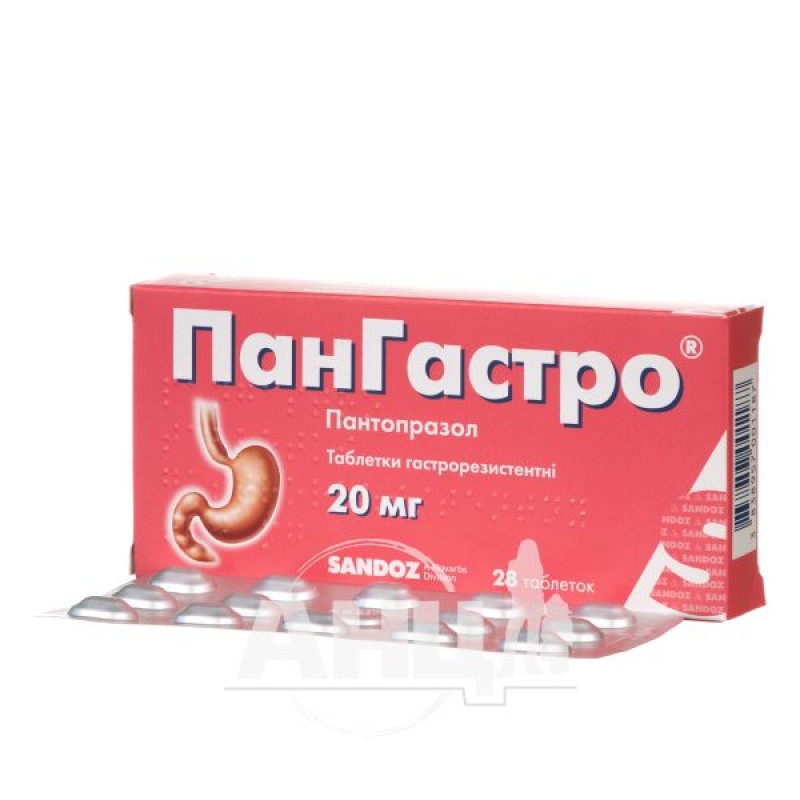Pangastro gastro-resistant tablets 20 mg blister No. 28

Pharmacological properties
Pharmacodynamics. Pantoprazole is a benzimidazole derivative that inhibits gastric acid secretion by specifically targeting the proton pump of the gastric parietal cells. Pantoprazole is converted to its active form in the acid tubules of the parietal cells and inhibits the N+/K+-ATPase, which blocks the final step in the formation of gastric acid. This inhibition is dose-dependent and affects both basal and stimulated gastric acid secretion. In most patients, symptoms resolve within 2 weeks. Like other proton pump inhibitors (PPIs) and H2-receptor inhibitors, pantoprazole reduces gastric acidity and, accordingly, increases gastrin levels in proportion to the decrease in acidity. The increase in gastrin levels is reversible. Since pantoprazole binds the enzyme distal to the cell receptors, it has the property of inhibiting the secretion of hydrochloric acid regardless of stimulation by other substances (acetylcholine, histamine, gastrin). Oral and intravenous dosage forms provide the same therapeutic effect.
Under the influence of pantoprazole, the fasting gastrin level increases. With short-term use, the upper limit of the norm is not exceeded in most cases. With long-term treatment, the gastrin level generally increases by 2 times. However, in some cases, an excessive increase in these levels is possible. As a result, a small part of patients with long-term treatment has a slight or moderate increase in the number of specific endocrine cells of the stomach (as in adenomatoid hyperplasia). However, according to the studies conducted so far, the formation of precursor cells of neuroendocrine tumors (atypical hyperplasia) or neuroendocrine tumors of the stomach, which were detected in animal experiments, has not been observed in humans. According to the results of animal studies, with a duration of treatment with pantoprazole for more than 1 year, an effect on the endocrine parameters of the thyroid gland cannot be excluded.
During therapy with antisecretory drugs, serum gastrin levels increase in response to decreased acid secretion. Chromogranin A (CgA) levels also increase due to decreased gastric acidity. Elevated chromogranin A levels may interfere with investigations for neuroendocrine tumors.
According to available literature, it is recommended to discontinue PPI therapy 5 days to 2 weeks before determining chromogranin A. This will allow the level of chromogranin A, which has increased as a result of PPI therapy, to return to normal.
Pharmacokinetics. In the dose range of 10-80 mg, the pharmacokinetics of pantoprazole in blood plasma are linear both when taken orally and when administered intravenously.
Distribution: The plasma protein binding of pantoprazole is approximately 98%. The volume of distribution is approximately 0.15 l/kg.
Biotransformation. The substance is almost completely metabolized in the liver. The main metabolic pathway is demethylation by CYP 2C19 followed by sulfate conjugation. Other metabolic pathways include oxidation by CYP 3A4.
Elimination. T ½ - about 1 h, clearance - about 0.1 l / h / kg. Several cases of delayed elimination have been recorded. Due to the specific binding of pantoprazole to the proton pump of parietal cells, T ½ does not correlate with a longer therapeutic effect (inhibition of hydrochloric acid secretion).
Most of the metabolites of pantoprazole (about 80%) are excreted by the kidneys, the rest - with feces. The main metabolite in both serum and urine is desmethylpantoprazole, conjugated with sulfate. T ½ of the main metabolite (about 1.5 h) is not much longer than that of pantoprazole.
Special patient groups. Poor metabolisers. Approximately 3% of Europeans have a low functional activity of the CYP 2C19 enzyme; they are called poor metabolisers. In these individuals, the metabolism of pantoprazole is probably mainly catalysed by the CYP 3A4 enzyme. After a single dose of 40 mg pantoprazole, the mean AUC (area under the plasma concentration-time curve) was approximately 6 times higher in poor metabolisers than in subjects with a functionally active CYP 2C19 enzyme (extensive metabolisers). The plasma Cmax was increased by approximately 60%. These findings do not affect the posology of pantoprazole.
Patients with impaired renal function (including patients on hemodialysis) do not require a reduction in the dose of pantoprazole. As in healthy individuals, T ½ of pantoprazole in these patients is short. Very little pantoprazole is dialyzed. Although T ½ of the main metabolite is slightly increased (2-3 hours), it is rapidly excreted and therefore does not accumulate.
Liver dysfunction. Although in patients with cirrhosis of the liver (class A and B according to the Child-Pugh classification) T ½ of the active substance increases to 7-9 hours and, accordingly, AUC increases 5-7 times, C max of pantoprazole in blood plasma increases only 1.5 times compared to healthy volunteers.
Children. After a single oral dose of 20 or 40 mg pantoprazole, AUC and Cmax in children aged 5-16 years were within the range of the corresponding values in adults. After a single dose of 0.8 or 1.6 mg/kg pantoprazole in children aged 2-16 years, there was no significant relationship between the clearance of pantoprazole and the patient's age or body weight. The AUC and volume of distribution were consistent with those obtained in studies in adults.
Indication
Duodenal ulcer; gastric ulcer; reflux esophagitis; Zollinger-Ellison syndrome and other hypersecretory conditions.Application
The drug is used in adults and directly under the supervision of a physician.
Intravenous administration of the drug is recommended only when oral administration is not possible. The drug is used in adults as prescribed and under the direct supervision of a physician.
There is data on the duration of IV treatment up to 7 days. Therefore, if clinically possible, a transition from IV administration to oral administration of the drug Pangastrite is carried out.
Recommended doses
Gastric ulcer, duodenal ulcer and reflux esophagitis - 1 vial (40 mg of pantoprazole) per day intravenously.
Long-term treatment of Zollinger-Ellison syndrome and other pathological hypersecretory conditions. The initial daily dose of the drug is 80 mg. If necessary, the dose can be titrated up or down, depending on the indicators of acid secretion in the stomach. If doses exceed 80 mg/day, they should be divided into 2 administrations. A temporary increase in the dose above 160 mg of pantoprazole is possible, but the duration of use should be limited only to the period necessary for adequate control of acid secretion.
If rapid reduction of acidity is required, an initial dose of 2 × 80 mg is sufficient in most patients to achieve the desired level (10 mEq/h) within 1 hour.
Hepatic insufficiency. Patients with severe renal insufficiency should not exceed a daily dose of 20 mg (½ vial of Pangastrite, 40 mg powder).
Renal insufficiency: No dose adjustment is necessary for patients with impaired renal function.
Elderly patients should not exceed a daily dose of 40 mg.
Method of administration. The ready-to-use solution is obtained by diluting the powder in a vial with 10 ml of 0.9% sodium chloride injection solution. The resulting solution can be administered immediately or infused after mixing with 100 ml of 0.9% sodium chloride injection solution or 5% glucose injection solution.
After preparation, the solution should be used within 12 hours. From a microbiological point of view, the diluted product should be used immediately.
Pangastrit should not be prepared or mixed with solvents other than those listed above.
The drug is intended for intravenous administration over 2-15 minutes. The vial is intended for single use only. Before use, it is necessary to visually inspect the vials with the drug (in particular, for color change, the presence of sediment).
Contraindication
Hypersensitivity to the active substance, benzimidazole derivatives or any component of the drug.
Side effects
Adverse reactions can be expected to occur in approximately 5% of patients. The most commonly reported adverse reactions are injection site thrombophlebitis. Diarrhea and headache have occurred in approximately 1% of patients.
Adverse effects are classified by frequency of occurrence into the following categories: very common (≥1/100), common (≥1/100 and 1/10), uncommon (≥1/1000 and 1/100), rare (≥1/10,000 and 1/1000), very rare (1/10,000), unknown (frequency not determined based on available data).
From the blood and lymphatic system: rarely - agranulocytosis; very rarely - leukopenia, thrombocytopenia, pancytopenia.
Gastrointestinal tract: often - pain in the epigastric region; polyps from the fundic glands (benign); infrequently - diarrhea, nausea, vomiting, bloating and flatulence, constipation, dry mouth, pain and discomfort in the abdomen.
From the hepatobiliary system: infrequently - increased levels of liver enzymes (transaminases, γ-glutamyltransferase); rarely - increased levels of bilirubin; unknown - hepatocyte damage, jaundice, hepatocellular insufficiency.
On the part of the immune system: rarely - hypersensitivity reactions (including anaphylactic reactions, anaphylactic shock).
Skin and subcutaneous tissue disorders: infrequently - skin rash, rash, itching; rarely - urticaria, angioedema; unknown - Stevens-Johnson syndrome, Lyell's syndrome, erythema multiforme, photosensitivity, subacute cutaneous lupus erythematosus (see Precautions).
Musculoskeletal and connective tissue disorders: uncommon - fracture of the hip, wrist or spine; rare - arthralgia, myalgia; unknown - muscle spasm as a result of electrolyte imbalance.
From the nervous system: infrequently - headache, dizziness; rarely - taste disturbance; unknown - paresthesia.
On the part of the psyche: infrequently - sleep disorders; rarely - depression (with complications); very rarely - disorientation (with complications); unknown - hallucinations, confusion (especially in patients with a predisposition to these disorders, as well as exacerbation of these symptoms if they are present).
On the part of the organ of vision: rarely - visual impairment/blurred vision.
Renal and urinary disorders: not known - interstitial nephritis (with possible progression to renal failure).
Metabolism and metabolic disorders: rarely - hyperlipidemia and increased lipid levels (TG, cholesterol), changes in body weight; unknown - hyponatremia, hypomagnesemia (see Features of use), hypocalcemia 1 in combination with hypomagnesemia, hypokalemia.
From the reproductive system and mammary glands: rarely - gynecomastia.
1 Hypocalcemia simultaneously with hypomagnesemia.
Special instructions
Malignant neoplasms of the stomach. Symptomatic response to the use of pantoprazole may mask the symptoms of malignant neoplasms of the stomach and complicate the diagnosis.
In case of threatening symptoms (e.g. rapid unwanted weight loss, frequent vomiting, dysphagia, haematemesis, anemia, melena) and when there is suspected or confirmed gastric ulcer, it is necessary to exclude the possibility of malignant neoplasms.
If, despite adequate treatment, symptoms persist, additional examinations should be performed.
Hepatic impairment: In patients with severe hepatic impairment, liver enzyme activity should be monitored during therapy. If their activity increases, treatment should be discontinued.
HIV protease inhibitors: Concomitant use of pantoprazole with HIV protease inhibitors (such as atazanavir), whose absorption depends on intragastric pH, is not recommended due to a significant reduction in their bioavailability (see Interactions with other medicinal products).
If the combination of atazanavir with a PPI cannot be avoided, close clinical monitoring (including viral load) is recommended. Do not exceed a daily dose of pantoprazole 20 mg.
Gastrointestinal infections caused by bacteria. Pantoprazole, like other PPIs, may increase the number of bacteria normally present in the upper gastrointestinal tract. Treatment with the drug may slightly increase the risk of developing gastrointestinal infections caused by bacteria such as Salmonella and Campylobacter or C. difficile.
Hypomagnesemia. Severe hypomagnesemia has been reported in patients receiving PPIs such as pantoprazole for at least 3 months and in most cases for a year. The following serious clinical manifestations of hypomagnesemia may occur and progress insidiously: fatigue, tetany, delirium, convulsions, dizziness and ventricular arrhythmia. In most cases of hypomagnesemia, the condition of the patients improved after magnesium replacement therapy and discontinuation of the PPI.
Patients requiring long-term therapy or patients taking PPIs in combination with digoxin or drugs that can cause hypomagnesemia (e.g. diuretics) should have their magnesium levels measured before starting PPIs and periodically during treatment.
Sodium: This medicine contains less than 1 mmol sodium (23 mg) per vial, i.e. essentially “sodium-free”.
Bone fractures. Long-term treatment (more than 1 year) with high doses of PPIs may slightly increase the risk of fractures of the hip, wrist and spine, mainly in the elderly or in the presence of other risk factors. Observational studies suggest that the use of PPIs may increase the overall risk of fractures by 10-40%. Patients at risk of osteoporosis should be treated according to current clinical guidelines and consume adequate amounts of vitamin D and calcium.
Subacute cutaneous lupus erythematosus (SCLE). PPIs have been associated with very rare cases of SCLE. In case of skin lesions, especially after exposure to direct sunlight, and if these lesions are accompanied by joint pain, the patient should seek medical advice immediately and healthcare professionals should consider stopping pantoprazole. SCLE after previous treatment with a PPI may increase the risk of developing SCLE with other PPIs.
Effect on laboratory tests. Elevated chromogranin A levels may interfere with the diagnosis of neuroendocrine tumours. To avoid this effect, pantoprazole treatment should be discontinued at least 5 days before chromogranin A measurements. If chromogranin A and gastrin levels have not returned to the reference range after baseline laboratory tests, these should be re-measured 14 days after discontinuation of PPI treatment.
Use during pregnancy or breastfeeding
Pregnancy. Experience in pregnant women is limited. Available data on pregnant women (approximately 300-1000 exposures) do not indicate malformative or feto/neonatal toxicity of pantoprazole. Reproductive toxicity has been observed in animal reproduction studies. The drug should not be used during pregnancy unless clearly necessary.
Breastfeeding. Animal studies have shown excretion of pantoprazole in breast milk. There is evidence of excretion of pantoprazole in human breast milk. A risk to the newborn/infants cannot be excluded. A decision must be made whether to discontinue breast-feeding or to discontinue/abstain from therapy with this medicine taking into account the benefit of breast-feeding for the child and the benefit of therapy for the woman.
Children: Pangastrite, powder for solution for injection, is not recommended for use in children under 18 years of age as data on safety and efficacy in this age group are limited.
Ability to influence the reaction rate when driving vehicles or operating other mechanisms. Pantoprazole has no or very minor influence on the reaction rate when driving vehicles or operating other mechanisms.
When treating with this drug, undesirable reactions such as visual disturbances and dizziness are possible. If such reactions occur, patients should not drive or operate machinery.
Interactions
Medicinal products whose absorption depends on pH: As a result of complete and prolonged inhibition of hydrochloric acid secretion, pantoprazole may affect the absorption of drugs for which the pH of the gastric juice is an important factor in their bioavailability (e.g. some antifungal drugs such as ketoconazole, itraconazole, posaconazole or other drugs such as erlotinib).
HIV protease inhibitors: Concomitant use of pantoprazole with HIV protease inhibitors (such as atazanavir), whose absorption depends on intragastric pH, is not recommended due to a significant reduction in their bioavailability (see Precautions).
If concomitant use of HIV protease inhibitors and PPIs cannot be avoided, close clinical monitoring (e.g. viral load) is recommended. The daily dose of pantoprazole should not exceed 20 mg. Dose adjustment of HIV protease inhibitors may be necessary.
Indirect anticoagulants (phenprocoumon and warfarin). Concomitant use of pantoprazole with warfarin or phenprocoumon did not affect the pharmacokinetics of warfarin, phenprocoumon or INR (international normalized ratio). However, increases in INR and prolongation of prothrombin time have been reported in patients receiving concomitant PPIs and warfarin or phenprocoumon. Increases in INR and prolongation of prothrombin time may lead to pathological bleeding and even death. In the case of such combined use, monitoring of INR and prothrombin time is necessary.
Methotrexate: Concomitant use of this drug at high doses (e.g. 300 mg) and PPIs has been shown to increase methotrexate levels in some patients. Therefore, when high doses of methotrexate are used, e.g. for the treatment of cancer and psoriasis, pantoprazole may need to be temporarily discontinued.
Other drug interaction studies: Pantoprazole is extensively metabolized in the liver by the cytochrome P450 enzyme system. The main metabolic pathway is demethylation by CYP 2C19 and, among other metabolic pathways, oxidation by CYP 3A4.
Interaction studies with other drugs that share similar metabolic pathways, including carbamazepine, diazepam, glibenclamide, nifedipine, and oral contraceptives containing levonorgestrel and ethinyl estradiol, have not revealed clinically significant interactions.
The results of a number of drug interaction studies indicate that pantoprazole does not affect the metabolism of active substances with the participation of the enzymes CYP 1A2 (caffeine, theophylline), CYP 2C9 (piroxicam, diclofenac, naproxen), CYP 2D6 (metoprolol), CYP 2E1 (ethanol) and the p-glycoprotein-associated absorption of digoxin.
The possibility of interactions of patoprazole with other drugs or compounds metabolized by this enzyme system cannot be excluded.
No interactions have been identified with simultaneous use with antacids.
Drug interaction studies have also been conducted with the simultaneous use of pantoprazole with certain antibiotics (clarithromycin, metronidazole, amoxicillin). No clinically significant interactions have been identified.
Medicinal products that inhibit or induce CYP 2C19. CYP 2C19 inhibitors, such as fluvoxamine, may increase the systemic exposure of pantoprazole. Patients receiving long-term therapy with high doses of pantoprazole or patients with hepatic impairment may require a dose reduction.
Inducers of enzymes that affect CYP 2C19 and CYP 3A4, such as rifampicin and St. John's wort (Hypericum perforatum), may reduce the plasma concentration of PPIs metabolized by this enzyme system.
Incompatibility. The solution for injection must not be mixed with other medicinal products except those specified in the APPLICATION section.
Overdose
Symptoms of overdose are unknown.
Doses up to 240 mg given intravenously over 2 minutes were well tolerated. Since pantoprazole is extensively protein bound, it is not almost completely removed by dialysis.
In case of overdose with clinical signs of intoxication, symptomatic and supportive therapy is used. There are no recommendations for specific therapy.
Storage conditions
At a temperature not exceeding 25 °C.
1-01-REC-CIS-0919
There are no reviews for this product.
There are no reviews for this product, be the first to leave your review.
No questions about this product, be the first and ask your question.








